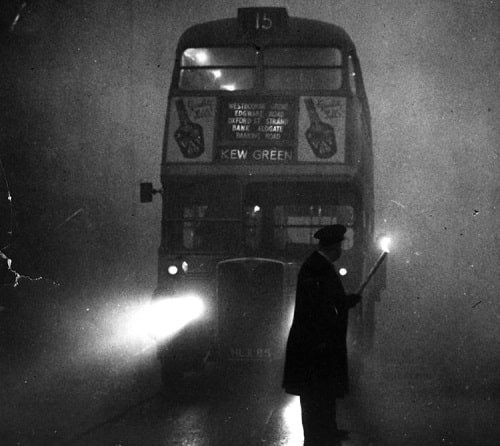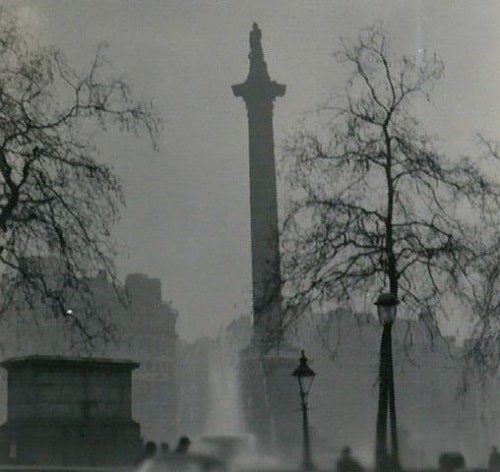On 5 December 1952, a great smog covered London in a deadly blanket. It would end up killing 12,000 people.
Features
The Great Smog of 1952: seventy years on
Jenny Watson, now 72, a child at that time, remembers being admitted to hospital with severe bronchitis due to the smog. “Even though I was only nearly three at the time, I remember how yellow and sulphuric and scary it looked," she recalls.
“Ever since then, I’ve had a weak chest. Any time I get a cold or a cough, it goes straight down to my chest and it takes me ages to get better. I was lucky as a lot of people died in the smog, but doctors have told me I have the smog to thank for my vulnerable lungs.”
The Great Smog lasted from Friday 5 December to Tuesday 9 December 1952. Mainly the very young and those over 45 fell victim to the fatal fog. It’s estimated that 15,000 people were registered as too ill to work.
 An inspector carries a flare to guide the driver of the number 15 bus to Kew Green during the Great Smog. Flares were carried on buses for this purpose into the 1960s. Photograph: Alan Farrow / Flickr
An inspector carries a flare to guide the driver of the number 15 bus to Kew Green during the Great Smog. Flares were carried on buses for this purpose into the 1960s. Photograph: Alan Farrow / Flickr
Coal and sulphur
The smog was caused by the combination of water droplets with soot and sulphur from coal that powered London’s industry and kept homes warm. Additionally, there was pollution and smoke from vehicle exhaust, particularly from steam locomotives and diesel-fuelled buses which had replaced the recently abandoned electric tram system.
The smog covered a thousand square miles and was so dense that it even seeped indoors – cinema screenings and concerts were abandoned or cancelled. Ambulances crawled around the city taking patients to overcrowded hospitals. Like a science-fiction nightmare, the fog filled the streets.
From a visible to invisible killer?
Today, we might not see the stark evidence of air pollution so visibly as that terrible week. But air pollution still claims lives. According to the government’s official figures, human-made air pollution in the UK causes between 28,000 and 36,000 deaths every year. By 2025 it’s estimated that air pollution will have cost the NHS £1.6 billion since 2017.
Air pollution is also more complex today. During the Great Smog of December 1952, 18% of UK coal was used for home heating, producing 60% of our wintertime smoke pollution.
Today, air pollution comes from tiny particulate matter (PM2.5) created by cars, trucks, buses, factories and construction sites. Too small to see, PM2s can be inhaled deep into lungs and cause heart and lung disease. Nitrogen monoxide is also emitted by vehicles and construction equipment.
Jenny remembers how in her day, the effects of air pollution were immediately visible: “When I was a child, if you travelled by train you’d expect to be covered in soot – just opening the door you’d get hands and clothes black. Our buildings were black, not like they are today.
“Today you can’t see air pollution so much, so people assume it’s not going to harm you. In many ways, although we had the smog [followed by the smog in December 1962] we were a lot healthier. In 1952, you had to be quite wealthy to have a car. Everyone went by public transport or you walked, or cycled. There wasn’t the obesity that you have today.”
 Nelson's Column during the Great Smog of 1952. Photograph: N T Stobbs / Geograph.co.uk
Nelson's Column during the Great Smog of 1952. Photograph: N T Stobbs / Geograph.co.uk
Solutions – what have we learned?
In his book The Invisible Killer: The Rising Global Threat of Air Pollution - And How We Can Fight Back, air pollution scientist Dr Gary Fuller explains that air pollution has certainly got more complex. “London is no longer plagued by coal-induced winter smogs and year-long haze. But pollution comes from different sources, including ammonia from farming.”
But Fuller also says that there has been progress, with more electric vehicles on the streets and London’s first low emission zone in 2019, followed by its planned expansion in 2023.
“Solving our air pollution problem seems a massive task. It feels too big for any of us to make a difference, but we all need to be part of the fight back. Air pollution is caused by the way we live our lives yet simple changes can make a big difference, the greatest opportunities are in the way we travel reducing traffic in our cities will do so much more than reduce pollution, [it will give us health benefits too].”
Governments also need to be quicker and take the issue seriously: “The smogs of the 50s and 60s showed how short periods of severely polluted air could harm the health of thousands of people, but it took another 40 years before [we realised] that breathing polluted air every day was shortening our lives. We must recognise that our air is a precious resource that should be protected and not used as a waste disposal mechanism.”
The British Safety Council's Time to Breathe campaign is aimed at protecting the health of outdoor workers. For more information visit our campaign website here #TimetoBreathe
FEATURES

Underpinning safety training with neuroscience for long lasting impact
By SSE Active Training Team (ATT) on 30 November 2025
A behavioural safety training programme developed by Active Training Team for energy provider SSE has been carefully designed with neuroscientific principles in mind – resulting in a prestigious industry award for Best Training Initiative in 2024.

Why a painted line will never be enough
By UK Material Handling Association (UKMHA) on 20 November 2025
Businesses that operate material handling equipment like forklifts are being urged to submit accident and near miss details to a new confidential reporting portal so the industry can identify what needs to be done to improve safety standards.

Why workplace transport training is changing in 2026 and what it means for employers
By AITT on 26 November 2025
New workplace transport training categories due in January mean it is essential to ensure operators of material handling equipment have the necessary training for the exact type of machine they use, and accredited training providers are an ideal source of advice and conversion training.



